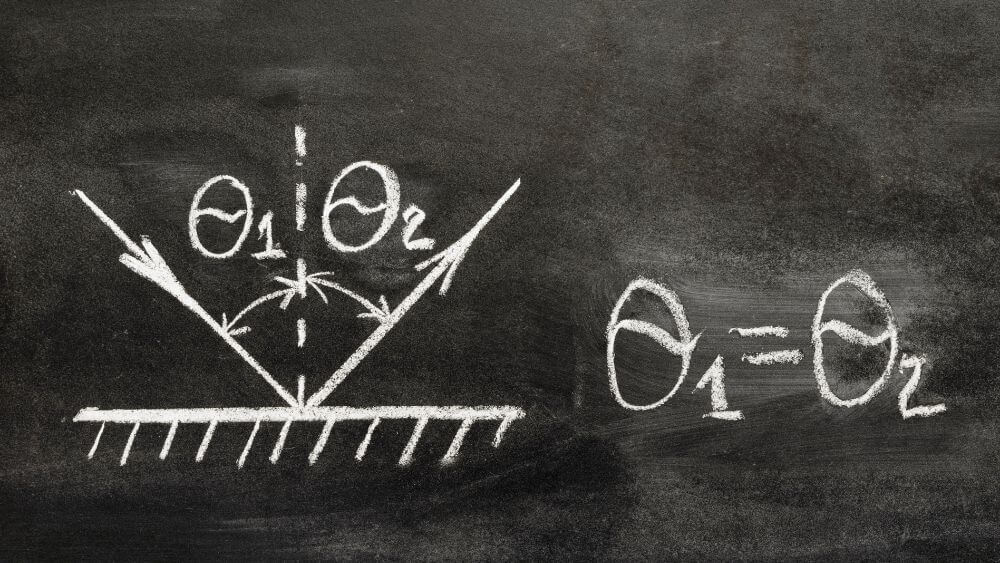Light – Laws of Reflection & Eye

Light is a very important part of our lives as it is one of the essential components required to see. Let’s try to understand light at a greater depth.
Contents
Laws of Reflection
Let’s do an experiment to understand reflection of light.
- Take a comb and cover all the gaps except one in the centre.
- Take a piece of paper on a table and place the comb perpendicular to the piece of paper.
- Now take a flashlight against the comb so that the light passes through the single slit and falls against the piece of paper. Keep the flashlight and the paper steady.
- Now, take a small mirror and place it perpendicularly on the paper such that the beam of light falls on the mirror.
- The mirror will reflect the light falling on it and produce a reflected beam of light on the paper.
Now, carefully trace the following with a pencil and scale:
- The beam of light that is falling or is incident on the mirror.
- The beam of light reflected by the mirror.
- The plane along which the mirror is held.
Now, draw a line at a 90 degree angle to the plane of the mirror through the point at which the incident ray strikes. This line is known as the normal.
- The ray of light that falls on the surface of the mirror is known as the incident ray.
- The angle between the incident ray and the normal is known as the angle of incidence.
- The ray of light reflected by the mirror is known as the reflected ray.
- The angle between the normal and the reflected ray is known as the angle of reflection.
The angle of reflection and the angle of incidence is always equal. This is one of the laws of reflection.
Now, keeping the entire setup the same, move a part of the paper a over the edge of the table. Now as the light is reflected by the mirror, fold the edge of the paper on which the reflected ray is falling. You will notice that the reflected light no longer falls on the piece of the paper. Therefore when we fold the piece of paper and create a new plane below, the reflected light no longer falls on it i.e., the incident ray, reflected ray and normal all lie on the same plane. This is another law of reflection.
Mirror Image and Lateral Inversion:
As you already know, the image produced by a mirror is a virtual image and cannot be produced on a screen. Now, imagine you are standing in front of a mirror. You will notice that your right hand is actually the reflected image’s left hand and your left hand is its right hand. This phenomenon is known as lateral inversion.
Regular and Diffused Reflection:
- When parallel rays of light fall on an irregular surface, the reflected rays of light are not parallel. This phenomenon is known as diffused or irregular reflection. This is caused by irregularities in the reflecting surface, for example that of a piece of cardboard. It is not a failure of the law of reflection.
- When parallel rays of light on striking a smooth surface like a mirror produce parallel reflected light rays, the phenomenon is called regular reflection.
- Objects that are seen in the light generated by other objects are known as illuminated objects. For example, the objects we see reflect light from other objects which is why we are able to visualize them. The Moon reflects the light of the Sun and that is why the Moon is visible to us.
- Objects that emit their own light and also illuminate other objects are known as luminous objects. Examples include the Sun, flame of a candle, electric lamp, etc.
Multiple Image Formation:
When you stand in front of a mirror you can see your reflection. Now, if you place a second mirror at various angles to the first mirror, the image will be reflected in this second mirror.
For example, after you get a haircut, the barber usually takes a second mirror and places it behind your head. Why does she/he do this? This is because the image of the back of your hand is produced on the second mirror which is then reflected by the mirror in front of you. Thus, you can see the image of the back of your head in the mirror in front of you.
The number of images produced varies depending on the angle at which the two mirrors are held with respect to each other. When two mirrors are held parallel and facing each other, infinite images are formed.
Sunlight and Refraction:
Sunlight is a white light. But actually it is made up of seven colours – violet, indigo, blue, green, yellow, orange and red. Often we see a rainbow in the sky. The formation of a rainbow occurs due to splitting up of sunlight into its constituents. The phenomenon of splitting of light is known as dispersion of light.
A prism can be used to split up light.
The Eye:
The eye is the organ that makes it possible for us to see things.
The eye has a spherical shape. It has a tough, white outer coat that protects the inner part of the eye from damage.
- Cornea – The transparent outer part of the eye is known as the cornea.
- Iris – The dark muscular structure behind the cornea is known as the iris. The iris is the part of the eye that gives it its distinctive colour. The iris has a small aperture known as the pupil. The iris controls the size of the pupil and thereby controls the amount of light entering the eye.
- Lens – There is a lens behind the pupil of the eye which helps in generating the images that we see through our eyes. This lens is thick at the center.
- Retina – Light from any object is focussed by the lens on a layer at the back of the eye known as the retina. It contains many nerve cells which transmit signals through the optic nerve to the brain; this is how we see an image. There are two types of nerve cells:
-
- Cone cells which are sensitive to bright light and colour
- Rod cells which are sensitive to dim light
- Blind Spot – At the junction of the retina and the optic nerve there are no nerve cells and as a result no vision is possible at this spot. This is called the blind spot.
The distance at which an object must be placed so that it can be observed clearly and comfortably is 25cm from the eyes. The ability to view something clearly varies with age. Some people can see close objects clearly but have trouble seeing objects at a distance. On the other hand some people can see objects at a distance clearly but have trouble seeing close objects.
At old age, the eyesight may become foggy as the lens becomes foggy. The person is said to have cataract. With the development of technology this can easily be solved by replacing the foggy lens with an artificial lens.
Still and Moving Images:
- The impression of an image does not disappear immediately from the retina; it lasts for 1/16th of a second. Therefore, if the still image of a moving object is flashed before the eye at a rate of more that 16 per second, our eyes will perceive it as a moving object.
- This is in fact the principle behind movies. A movie is made up of a sequence of separate pictures which are projected at a rate of 24 per second and thus, we observe it as a moving picture.
Care of The Eyes:
The eyes are a very important organ of our body and so it is important to take proper care of them.
- Have regular eye check ups and use spectacles if recommended.
- Do not use too little or too much light. Too little light causes a strain on the eyes resulting in headaches. Too much light can be damaging for the retina.
- Do not look directly into the sun or a laser light or any strong source of light.
- Always read at the normal distance for vision. Reading objects too close or too far from the eyes can cause damage.
- Often dust and particles enter the eyes. Do not rub your eyes, wash them thoroughly.
- Deficiency in vitamin A can cause eye trouble, especially night blindness. Therefore, foods rich in vitamin A such as broccoli, raw carrots and green vegetables should be consumed regularly.
Braille System For The Visually Impaired:
Many individuals are visually impaired. This refers to a partial or complete loss of sight either from birth or due to a disease or injury. Visually impaired individuals depend on their other senses such as hearing and touch to interact with the world around them,
The Braille System is a system for writing and printing for visually impaired individuals. This system consists of 63 dot patterns or characters which are slightly raised thereby allowing people to recognize the characters through touch. The pattern of dots represents letters and numbers. There is Braille Code for common languages, mathematics and scientific notations. Braille texts can be hand written but nowadays machines have been developed which can print such texts.
Summary:
- Incident Ray
- Reflected Ray
- Normal
- Mirror Image and Lateral Inversion
- Regular and Irregular Reflection
- Illuminated and Luminous Objects
- Multiple Image Formation
- Sunlight and Refraction
- Eye and its parts
- Care of The Eye
- Still and Moving Images
- Braille System






Responses